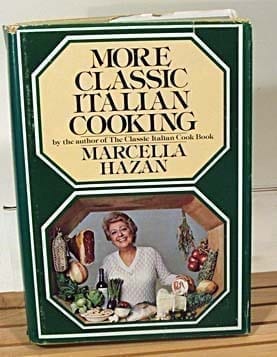

She worked her way up to frying, sheathing slices of zucchini in pastella, a batter of flour and water. Hazan began modestly, with soups made from potatoes and leeks, or cannellini and parsley. She turned to “Il talismano della felicità” (“ The Talisman of Happiness”), a book by the Italian food writer Ada Boni, whose words ferried her back to the home she missed. There was only one way for Hazan to survive in this country: learn to cook. To Hazan’s shock, some foods were even frozen. The poor tomatoes were subjected to chemical malpractice in America-gassed, transported over a long distance, then hastened back to life like zombies. American supermarkets likewise flummoxed her, with their produce and meats suffocating in plastic. She could not comprehend the American impulse to pollute a dish with such sweet sludge.

When he poured ketchup over hamburger meat, she was appalled. Though he was a man with a sophisticated palate, he also knew how to enjoy America’s simple gustatory pleasures. During her first days in America, Victor took Hazan to a café. But she soon felt the weight of all she’d left behind in Italy. Hazan was hopeful the day, in September, when she rode a taxi from Manhattan to Victor’s apartment in Forest Hills, Queens. Victor and Hazan were married in 1955, and Victor’s parents persuaded him to join them in New York and work at his father’s fur business. Hazan, meanwhile, only knew how to make gruel for pigs. Food stimulated Victor, and he cooked often. It was only when she met her future husband, a quietly charismatic Italian-born man named Victor Hazan, in the early nineteen-fifties, that her culinary interests deepened. She pursued studies in biology and the natural sciences at the University of Ferrara, with plans to become a teacher. During the war, she would prepare gruel from mulberry leaves, water, and polenta flour to fatten up piglets for slaughter. Her hand refused to fully straighten from that point forward, but-thank goodness-it functioned well enough to grip a knife.įor many years, Hazan’s experience in the kitchen was limited to menial chores. Hazan needed multiple surgeries from an orthopedic surgeon at a hospital in the family’s native Italy, which forced them to move back to Cesenatico, the fishing town where Hazan (née Polini) was born. Her doctor removed the cast, revealing gangrenous skin that resembled the flesh of a rotting peach. The pain didn’t subside after a few days, though, and the color of her hand began to dull. At the hospital, her arm was placed in a cast that stretched from her shoulder to the tips of her knuckles. It was 1931, and she and her family were living in the Egyptian city of Alexandria. When Marcella Hazan was seven years old, she fell on the beach and broke her right arm.


 0 kommentar(er)
0 kommentar(er)
